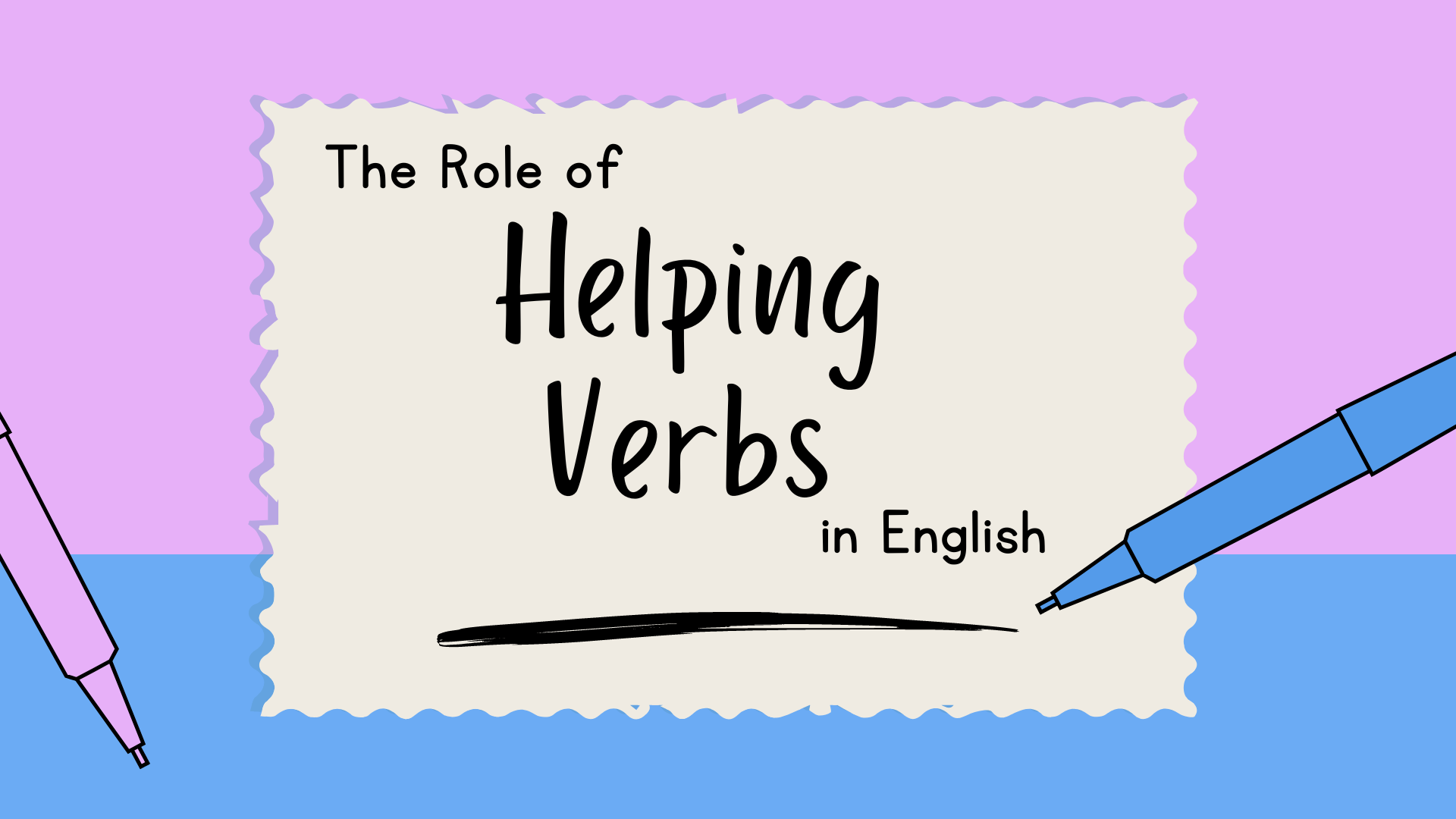Introduction
Helping verbs, also known as auxiliary verbs, play an essential role in the English language. While they may not always stand out in a sentence, their presence is crucial for constructing clear and meaningful sentences. Helping verbs assist the main verbs in conveying additional meaning, such as tense, mood, or voice. Without them, it would be challenging to express complex actions or conditions in a grammatically correct way.
In this article, we’ll explore what helping verbs are, how they function, and why they’re important in English grammar. We’ll break down the different types of helping verbs, provide examples, and explain how to use them correctly in various contexts.
What Are Helping Verbs?
Helping verbs are verbs that assist the main verb in a sentence. They don’t carry much meaning on their own but work in combination with a main verb to form verb tenses, questions, negatives, and other structures. These verbs modify the main verb to create a more precise expression of the action.
Common Helping Verbs
The most commonly used helping verbs in English are:
- To be: is, am, are, was, were, be, being, been
- To have: has, have, had
- To do: does, do, did
Additionally, modal verbs like can, could, may, might, must, shall, should, will, and would also function as helping verbs in sentences.
Main Verbs vs. Helping Verbs
The key difference between a main verb and a helping verb is that the main verb carries the core meaning of the sentence, while the helping verb aids the main verb to indicate time, necessity, possibility, or other nuances.
For example:
- He is running. (Here, “is” is the helping verb, and “running” is the main verb.)
- They have finished their homework. (In this sentence, “have” is the helping verb, and “finished” is the main verb.)
Types of Helping Verbs
Helping verbs can be divided into two broad categories: primary helping verbs and modal helping verbs. Each category has its unique function and purpose in sentence construction.
A. Primary Helping Verbs
Primary helping verbs are the most common type of helping verbs in English. They include the verbs to be, to have, and to do. These verbs can also function as main verbs in a sentence.
- To be: Used to form continuous and passive verb tenses.
- To have: Used to form perfect tenses.
- To do: Used to form negatives, questions, and to add emphasis.
Let’s look at each of these in more detail:
1. To Be
The verb “to be” is perhaps the most versatile and widely used helping verb in English. It helps to form continuous (progressive) tenses and passive voice.
- Continuous Tense: Used to describe ongoing actions.
Example: She is cooking dinner. (The helping verb “is” indicates that the action is happening at the present moment.)
- Passive Voice: Used when the subject receives the action rather than performing it.
Example: The book was written by the author. (The helping verb “was” helps form the passive construction, where the action is being done to the subject.)
2. To Have
The verb “to have” is used as a helping verb to form perfect tenses. These tenses express actions that are completed at different times.
- Present Perfect: Describes an action that occurred at an unspecified time before now.
Example: I have finished my homework. (The helping verb “have” indicates that the action is complete.)
- Past Perfect: Describes an action that was completed before another past event.
Example: She had already left when I arrived. (The helping verb “had” shows that the action was completed before another past action.)
- Future Perfect: Describes an action that will be completed at a specific time in the future.
Example: By tomorrow, they will have finished the project. (The helping verb “will have” shows that the action will be completed in the future.)
3. To Do
The verb “to do” serves multiple purposes in English. It can be used to form questions, and negatives, and to add emphasis to a sentence.
- Forming Questions: The helping verb “do” is used in questions to invert the subject and the verb.
Example: Do you like ice cream? (The helping verb “do” is used to ask a question.)
- Forming Negatives: The helping verb “do” is used to form negative sentences.
Example: I do not know the answer. (The helping verb “do” forms the negative with “not.”)
- Adding Emphasis: “Do” can be used to emphasize a point in positive statements.
Example: I do want to attend the meeting. (The helping verb “do” emphasizes the verb “want.”)
B. Modal Helping Verbs
Modal verbs are a unique subset of helping verbs that convey possibility, necessity, ability, or permission. They don’t change form based on the subject or tense and are always followed by the base form of the main verb.
Common modal helping verbs include:
- Can: Expresses ability or possibility.
Example: She can speak four languages.
- Could: Expresses past ability or polite requests.
Example: Could you help me with this task?
- May: Expresses permission or possibility.
Example: You may leave early today.
- Might: Expresses a lesser possibility than “may.”
Example: It might rain later.
- Must: Expresses necessity or obligation.
Example: You must finish your homework.
- Shall: Indicates future actions (used more in British English).
Example: We shall overcome.
- Should: Expresses advice or recommendation.
Example: You should study for the exam.
- Will: Expresses future actions or certainty.
Example: They will arrive at 6 p.m.
- Would: Used in conditional sentences and polite requests.
Example: I would like to order a coffee.
How Helping Verbs Function in Sentences
Helping verbs are crucial for constructing grammatically correct sentences in English. They work with main verbs to express different tenses, voices, and moods. Let’s explore how helping verbs function in various contexts:
A. Tense Formation
Helping verbs are integral to forming different verb tenses. Without them, it would be impossible to indicate whether an action occurred in the past, present, or future.
- Present Continuous: She is eating lunch.
(“Is” helps form the present continuous tense, showing an action happening now.)
- Past Perfect: They had left before we arrived.
(“Had” helps form the past perfect tense, indicating an action completed before another.)
- Future Perfect: By next year, we will have completed the project.
(“Will have” helps form the future perfect tense, indicating an action that will be completed in the future.)
B. Voice (Active vs. Passive)
Helping verbs form the passive voice, which shifts the focus of the sentence from the action’s doer to the action’s receiver.
- Active Voice: The chef cooked the meal.
(In the active voice, the subject acts.)
- Passive Voice: The meal was cooked by the chef.
(In the passive voice, the subject receives the action, and “was” is the helping verb.)
C. Mood (Indicative, Imperative, Subjunctive)
Helping verbs also play a role in expressing mood in English, whether indicating facts, giving commands, or describing hypothetical situations.
- Indicative Mood: Expresses facts or statements.
Example: He has finished the report.
- Imperative Mood: Gives commands or requests.
Example: You must submit the form by tomorrow.
- Subjunctive Mood: Describes hypothetical or non-real situations.
Example: If I were you, I would take the job.
Common Mistakes with Helping Verbs
Even though helping verbs are an essential part of English grammar, they can sometimes confuse learners. Here are some common mistakes and how to avoid them:
A. Omitting the Helping Verb
Sometimes, learners forget to include the helping verb in sentences, which leads to incomplete or incorrect sentences.
- Incorrect: She going to the store.
- Correct: She is going to the store.
In this example, the helping verb “is” is necessary to complete the sentence.
B. Misplacing the Helping Verb in Questions
When forming questions, the helping verb should come before the subject, but learners often misplace it.
- Incorrect: You can help me?
- Correct: Can you help me?
To form a question, the helping verb “can” must come before the subject “you.”
C. Confusing Modal Verbs
Modal verbs, such as “can” and “could,” are often confused with one another. It’s important to
remember that “can” is used for present ability, while “could” is used for past ability or polite requests.
- Incorrect: I can go to the party yesterday.
- Correct: I could go to the party yesterday.
5. Conclusion
Helping verbs may seem like small and simple words, but they play an essential role in shaping the meaning of sentences. Whether forming different tenses, expressing moods, or clarifying voice, helping verbs are crucial for effective communication in English. By understanding how helping verbs function and practicing their correct usage, learners can greatly improve their language skills.
In conclusion, helping verbs make it easier to express complex ideas with precision. They allow us to indicate when actions happen, who performs them, and the likelihood or necessity of events. Mastering helping verbs is key to mastering English grammar, making them an indispensable part of sentence construction.

